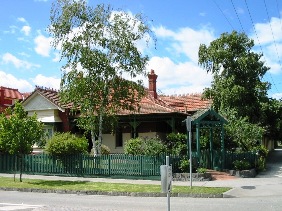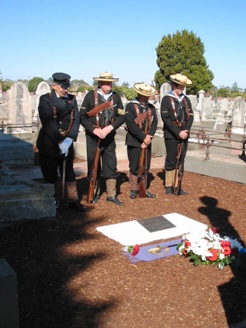Number 54 Wheatland Road, Malvern is a neat picturesque Queen Anne-style home. When Lily Laura Robertson née Locke (1878-1935) rented the residence in June 1910 from the estate of George Smith, it was the only building on the south-side between Lysterville Avenue and Tooronga Road. Located in a quiet secluded area away from the hustle and bustle of inner Melbourne, the home was to await the return to Australia of Lily’s husband. But fate, so often the arbiter of the best laid plans was to leave Lily a widow with a five year old son.

(2006)
Born at Liverpool, England on 13 January 1854, William George Robertson (1854-1910) arrived in Melbourne on 4 March 1858 on the Merchant Prince together with his parents William Robertson (d 1901) and Ann née Milne (d 1887). Educated at Neil’s private college in Carlton, he was understood to have enlisted in the Victorian Navy on 26 September 1870 and may have been one of the crewmen who accompanied HMVS Cerberus during its voyage from England. Robertson probably left the Navy to gain experience as an engineer where he worked with the shipping company Huddart Parker & Co principally onboard s.s. Wendouree. Described as 5 foot 2½ inches tall, slight build, hazel eyes and fair hair, in January 1890, he re-joined the Navy as Engineer serving on the Cerberus and Countess of Hopetoun. As a member of the Permanent Naval Forces, Robertson volunteered for service with the Victorian Naval Contingent to join the Allied forces in China – Australia’s first involvement in war on terrorism. His diary is historically significant as one of the few contemporary accounts of the conflict. While on active service, Robertson was promoted Chief Engineer on 22 February 1901.
Nineteen hundred and nine ushered a new era of naval defence in Australia. Australian patriotism and national pride was no longer satisfied with the annual Imperial naval subsidy for protection of the Pacific seas. As The Age editorial noted;
“Only an ignoble race, one sunk in luxury or sloth, would in the hour of trial look for succor [sic] and refuge from hired ships, even though manned by our brothers, while we stood helplessly by and made no attempt to strike a blow for ourselves”.
In February 1909, the Fisher Labour government ordered the building of three River Class destroyers in Scotland. Then at the Imperial Defence Conference in July, a shift in policy from the Admiralty and a rise of the German war machine settled the issue.
As the most experienced and competent engineer in the Australian Navy, it was decided that Robertson should benefit from being involved in the construction of HMS Yarra by Denny Bros of Dumbarton. (The other destroyer, HMS Parramatta was built by the Fairfield Shipbuilding and Engineering Co. in Govan). This would enable Robertson to oversee the re-assembling at Cockatoo Island, Sydney of the third destroyer initially built in Scotland, HMAS Warrego paving the way for another three – HMAS Huon, Torrens and Swan – to be constructed entirely in Australia under his supervision.

And so on 27 May 1909, along with Lieutenants Feakes and Biddlecombe, Robertson set sail for Scotland. A pragmatic man, three days before his departure, Robertson wrote out his last will and testament bequeathing his estate to his wife Lily whom he married at Essendon on 11 September 1901. Their only child, William Allan Robertson (1905-62) was born on 17 August 1905.
With construction of the Parramatta and Yarra in earnest, they were launched on the River Clyde on 9 February and 9 April 1910 respectively. By 10 September with the destroyers complete, the naval force under Captain Frederick Tickell was ready to set sail for Melbourne. Lieutenant-Commander Thomas Biddlecombe was given command of the Yarra. They left Portsmouth nine days later sailing through the Red Sea and the Indian Ocean stopping at Singapore (2 November) where repairs were made to a bent propeller, Broome (15 November), Fremantle (23 November) and Adelaide (7 December).

After an absence of 18 months, Robertson was eager to be home. In letters to his sister Jessie Semmens née Robertson (1865-1955), he “repeatedly expressed pleasure at his expected return”. Indeed, Lily travelled by train to Adelaide and spent two days with her husband. And a good thing too. The day after Lily left to return to Melbourne, her husband was dead.
Arriving in Victorian waters on the morning of Friday 9 December, the ships remained at anchor in Portland all day. Dignitaries welcomed the crew and a large number of people inspected the 700-tonne modern war vessels. A wireless message was sent to Williamstown indicating the fleet would depart Portland at 11:00pm that evening for the final leg of the 14,322 mile journey.
On Saturday, the people of Melbourne and Queenscliff put on a gay spectacular to celebrate the arrival. Over 1,150 guests crowded onboard the Courier forming the Commonwealth welcome party and were joined by the Lady Loch and Osprey each with over 200 State dignitaries. The flotilla left Port Melbourne pier in the morning sailing down the Bay where the destroyers were scheduled to enter at 12:30pm. Up until now, the voyage had been described by Captain Tickell as “singularly uneventful”. That was until tragedy struck.
William Robertson was conscientious in his work, a man who left nothing to chance. During the voyage, the steering gear on the Yarra had caused the crew some trouble. While Robertson “did not take to himself any blame for the wrong working of the gear”, he would nonetheless worry over his work. Eight miles south of Port Phillip Heads and steaming at 13 knots, the sea was moderate with a slight swell. At 11:56am, Able-Seaman John Doherty spoke briefly to Robertson who was sitting on the tiller casing smoking. Doherty disappeared for a while and returned in time to hear a splash in the water. It was Robertson. To the cries of “man overboard!” every bluejacket swung into action and “full speed astern” was relayed immediately to the engine room. Within four-and-a-half minutes the body of their much loved officer was rescued from the unforgiving waters of Bass Strait.
In the sick-bay room, Able-Seaman Norman Sangster used artificial resuscitation until the arrival of Able-Seaman George Randall, the sick berth steward from Parramatta. With the third boiler in action, at a rate of 25 knots, the Yarra made haste for a doctor with the Parramatta astern. Inside the Heads, signal flags fluttered from above the rigging calling for a doctor onboard the Courier to the ignorance of the distinguished guests. By 12:45pm, Drs James and Esler boarded the destroyer but it was all in vain. Robertson was a walking time bomb. With severe coronary artery disease and evidence of brain disease, he was liable to collapse at any time.
As the ships entered the Alfred Graving Dock in Williamstown a little after 3:15pm, several thousands of well-wishers oblivious to the events had gathered to welcome the arrival and hear the speeches. Amongst those in the crowd was Lily Robertson. In his speech, the acting Prime Minister, Billy Hughes echoed patriotic sentiments of the nation when he said;
“We, as a nation, realise that to achieve our destiny, to be left free to foster the arts of peace, we must be prepared for war. We must not shut our eyes, and be blind to the facts of life. We have to face the world as it was, to be ready to protect that which we held dear”.

“ROBERTSON
IN LOVING MEMORY OF
WILLIAM GEORGE
BORN 13 JAN. 1854 DIED 10 DEC. 1910
FIRST CASUALTY COMMONWEALTH NAVAL FORCE (RAN)
FORMED 25 NOV. 1910
DROWNED MAIDEN VOYAGE HMAS YARRA
WIFE LILY LAURA (NEE LOCKE)
BORN 17 FEB. 1878 DIED 22 JAN. 1935
UNVEILED APRIL 2007″
With the passing of the Naval Defence Act on 25 November 1910 thus creating the Commonwealth Naval Force, the death of Lieutenant-Engineer William Robertson marked the first casualty of what was later renamed the Royal Australian Navy in October 1911. He was buried with full military honours on Monday 12 December 1910 (CofE*T*134).
“Thunder pealed in the afternoon while from the Brighton railway station was being carried the coffin containing the body…Then rain poured down heavily for a few seconds. Suddenly the rain ceased, and as the seamen from the Yarra lifted the coffin, draped with the Union Jack, on to the waiting gun-carriage, the sun broke through the clouds and shone on the hilt of the dead officer’s sword, which lay with his cocked hat on the coffin”.
At a slow march, the procession played ‘Dead March in Saul’ through the lines of people who gathered in Bay Street, where the music ceased, and thence at quickstep along Nepean Highway and Hawthorn Road towards the Brighton General Cemetery. Rev Lynch of St. Paul’s Caulfield read the burial service and a firing party of 50 rifles cracked three volleys in succession. While the bugle sounded the ‘Last Post’, each of the 260 bluejackets and hundreds of mourners stood motionless. It was a poignant scene that Robertson witnessed during service in the Boxer Uprising in 1900 when he wrote;
“I witnessed a quaint and picturesque sight this morning, although a very mournful one. A Captain…stationed here died, and a large number of all the Allied Forces…followed the remains to the grave. When the procession arrived and the funeral service commenced, it was snowing heavily – what a strange weird sight. With the exception of the clergyman’s voice, everything was as still as the unfortunate officer whose memory we were paying the last tribute of respect. A strange feeling came over me, and I almost wished for the time when men will turn their swords into ploughshares. But the time is not yet”.
Source:
The Argus 12 December 1910 p7 & p8, 13 December 1910 p6.
The Herald 12 December 1910 p6.
Punch 19 September 1901 p340 & 15 December 1910 p901.
The Age 10 December 1910 p13, 12 December 1910 p6 & p7, 13 December 1910 p7.
Unknown Melbourne newspaper circa 27 May 1909.
War diary of WG Robertson 7 December 1900.
Inquest PROV VPRS 24/PO, Unit 860, 1910/1156.
Birth certificate of WG Robertson GRO March 1854 Volume 8b, Page 280.
Will of WG Robertson 24 May 1909.
Marriage certificate of WG Robertson & LL Locke 11 September 1901.
Corfield, J., “The Australian Illustrated Encyclopaedia of The Boxer Uprising 1899-1901” (2001) p221.
Jose, A., “The Official History of Australia in the War of 1914-1918”, Vol IX (1987) p lviii-lxii.
Research by Di Foster, Jenny Coates and Lois Comeadow.
